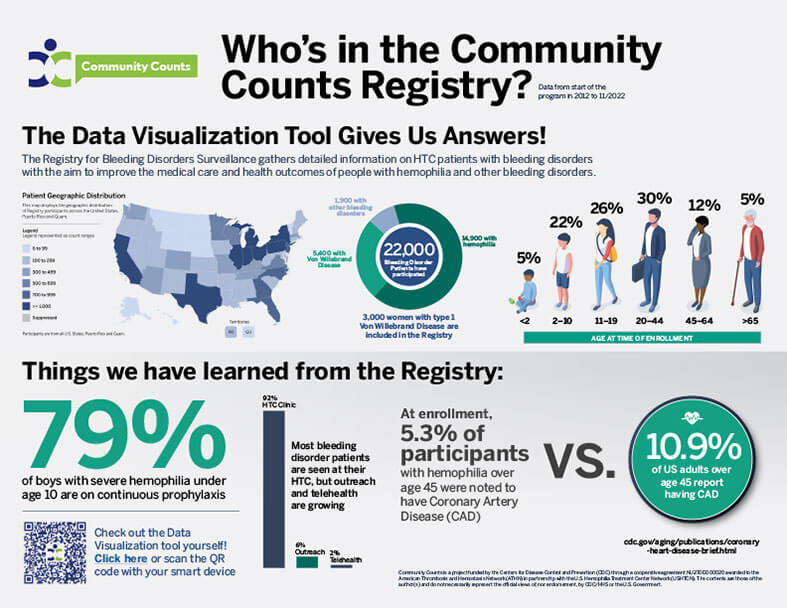Community Counts: CDC Public Health Surveillance Project For Bleeding Disorders
The Community Counts project is gathering data to learn more about patients with bleeding and clotting disorders at hemophilia treatment centers (HTCs) nationwide. The goal is to increase knowledge of inhibitors and other complications, reduce and prevent them from happening, and ultimately improve the quality of life of people with bleeding disorders.
Led by ATHN in partnership with regionally represented HTCs across the U.S. and the Centers for Disease Control and Prevention (CDC), Community Counts is happening at over 140 HTCs nationwide and includes more than 145,000 patients.
Community Counts is made up of 3 parts:
- HTC Population Profile is taking a head count of the bleeding and clotting disorders population and asking questions to learn more about the patients receiving care within the HTC network.
- Registry for Bleeding Disorders Surveillance is collecting detailed clinical information to monitor trends, identify risk factors and rates of complications, and identify high-risk populations for prevention programs.
- Mortality Reporting is gathering information about causes of death of patients who received care at HTCs and have died since September 30, 2011.
Demographic data from HTC visits through August 31, 2025 on over 145,000 unique individuals has been collected utilizing ATHN Clinical Manager and ATHN Study Manager. Detailed Registry data are also included on individuals with hemophilia or related bleeding disorders. To view Community Counts data reports visit Community Counts Data Reports on the CDC website.
Be a part of the progress.
ATHN’s Community Counts team is excited to share the following infographics about the Community Counts Registry and information specific to women and girls with bleeding disorders. We hope you will find these infographics helpful while talking to participants about the project. Feel free to download and print. Limited Community Counts information can be found on the CDC’s Community Counts data visualization tool.
To participate in Community Counts, simply talk to your HTC staff.
For more information, visit the Community Counts page on the CDC website.
Community Counts is a project supported by cooperative agreement NU27DD000020 awarded to the American Thrombosis and Hemostasis Network (ATHN) in partnership with the U.S. Hemophilia Treatment Center Network (USHTCN). The cooperative agreement is an annual financial assistance award totaling $4,300,000, which is 100% funded by the Centers for Disease Control and Prevention (CDC) and the U.S. Department of Health and Human Services (HHS). The contents are those of the author(s) and do not necessarily represent the official views of, nor an endorsement by CDC/HHS, or the U.S. Government.



